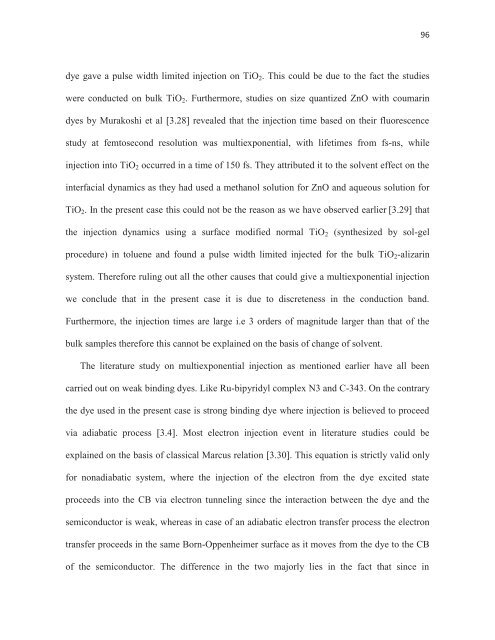CHEM01200604009 Sreejith Kaniyankandy - Homi Bhabha ...
CHEM01200604009 Sreejith Kaniyankandy - Homi Bhabha ...
CHEM01200604009 Sreejith Kaniyankandy - Homi Bhabha ...
You also want an ePaper? Increase the reach of your titles
YUMPU automatically turns print PDFs into web optimized ePapers that Google loves.
96<br />
dye gave a pulse width limited injection on TiO 2 . This could be due to the fact the studies<br />
were conducted on bulk TiO 2 . Furthermore, studies on size quantized ZnO with coumarin<br />
dyes by Murakoshi et al [3.28] revealed that the injection time based on their fluorescence<br />
study at femtosecond resolution was multiexponential, with lifetimes from fs-ns, while<br />
injection into TiO 2 occurred in a time of 150 fs. They attributed it to the solvent effect on the<br />
interfacial dynamics as they had used a methanol solution for ZnO and aqueous solution for<br />
TiO 2 . In the present case this could not be the reason as we have observed earlier [3.29] that<br />
the injection dynamics using a surface modified normal TiO 2 (synthesized by sol-gel<br />
procedure) in toluene and found a pulse width limited injected for the bulk TiO 2 -alizarin<br />
system. Therefore ruling out all the other causes that could give a multiexponential injection<br />
we conclude that in the present case it is due to discreteness in the conduction band.<br />
Furthermore, the injection times are large i.e 3 orders of magnitude larger than that of the<br />
bulk samples therefore this cannot be explained on the basis of change of solvent.<br />
The literature study on multiexponential injection as mentioned earlier have all been<br />
carried out on weak binding dyes. Like Ru-bipyridyl complex N3 and C-343. On the contrary<br />
the dye used in the present case is strong binding dye where injection is believed to proceed<br />
via adiabatic process [3.4]. Most electron injection event in literature studies could be<br />
explained on the basis of classical Marcus relation [3.30]. This equation is strictly valid only<br />
for nonadiabatic system, where the injection of the electron from the dye excited state<br />
proceeds into the CB via electron tunneling since the interaction between the dye and the<br />
semiconductor is weak, whereas in case of an adiabatic electron transfer process the electron<br />
transfer proceeds in the same Born-Oppenheimer surface as it moves from the dye to the CB<br />
of the semiconductor. The difference in the two majorly lies in the fact that since in
















